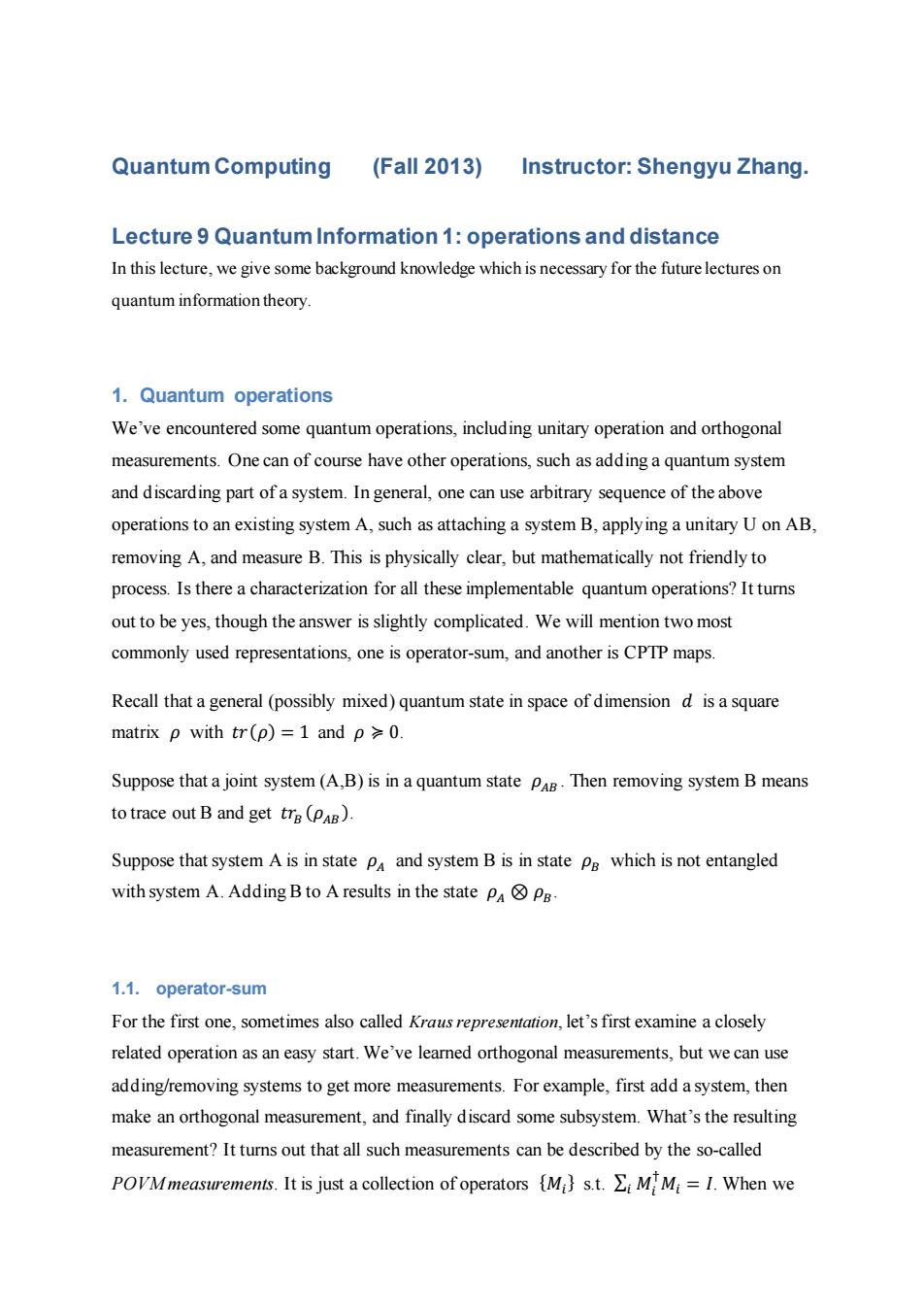
Quantum Computing (Fall2013) Instructor:Shengyu Zhang. Lecture 9 Quantum Information 1:operations and distance In this lecture,we give some background knowledge which is necessary for the future lectures on quantum information theory. 1.Quantum operations We've encountered some quantum operations,including unitary operation and orthogonal measurements.One can of course have other operations,such as adding a quantum system and discarding part of a system.In general,one can use arbitrary sequence of the above operations to an existing system A,such as attaching a system B,apply ing a unitary U on AB, removing A,and measure B.This is physically clear,but mathematically not friendly to process.Is there a characterization for all these implementable quantum operations?It turns out to be yes,though the answer is slightly complicated.We will mention two most commonly used representations,one is operator-sum,and another is CPTP maps. Recall that a general(possibly mixed)quantum state in space of dimension d is a square matrix p with tr(p)=1 and p0. Suppose that a joint system(A,B)is in a quantum state PAB.Then removing system B means to trace out B and get tra(PAB). Suppose that system A is in state Pa and system B is in state Pg which is not entangled with system A.Adding B to A results in the state PPa. 1.1.operator-sum For the first one,sometimes also called Kraus representation,let's first examine a closely related operation as an easy start.We've learned orthogonal measurements,but we can use adding/removing systems to get more measurements.For example,first add a system,then make an orthogonal measurement,and finally discard some subsystem.What's the resulting measurement?It turns out that all such measurements can be described by the so-called POVMmeasurements.It is just a collection of operators {Mi}s.t.i M;Mi =I.When we
Quantum Computing (Fall 2013) Instructor: Shengyu Zhang. Lecture 9 Quantum Information 1: operations and distance In this lecture, we give some background knowledge which is necessary for the future lectures on quantum information theory. 1. Quantum operations We’ve encountered some quantum operations, including unitary operation and orthogonal measurements. One can of course have other operations, such as adding a quantum system and discarding part of a system. In general, one can use arbitrary sequence of the above operations to an existing system A, such as attaching a system B, applying a unitary U on AB, removing A, and measure B. This is physically clear, but mathematically not friendly to process. Is there a characterization for all these implementable quantum operations? It turns out to be yes, though the answer is slightly complicated. We will mention two most commonly used representations, one is operator-sum, and another is CPTP maps. Recall that a general (possibly mixed) quantum state in space of dimension 𝑑 is a square matrix 𝜌 with 𝑡𝑟(𝜌) = 1 and 𝜌 ≽ 0. Suppose that a joint system (A,B) is in a quantum state 𝜌𝐴𝐵 . Then removing system B means to trace out B and get 𝑡𝑟𝐵 (𝜌𝐴𝐵). Suppose that system A is in state 𝜌𝐴 and system B is in state 𝜌𝐵 which is not entangled with system A. Adding B to A results in the state 𝜌𝐴 ⊗ 𝜌𝐵 . 1.1. operator-sum For the first one, sometimes also called Kraus representation, let’s first examine a closely related operation as an easy start. We’ve learned orthogonal measurements, but we can use adding/removing systems to get more measurements. For example, first add a system, then make an orthogonal measurement, and finally discard some subsystem. What’s the resulting measurement? It turns out that all such measurements can be described by the so-called POVM measurements. It is just a collection of operators {𝑀𝑖 } s.t. ∑ 𝑀𝑖 † 𝑖 𝑀𝑖 = 𝐼. When we
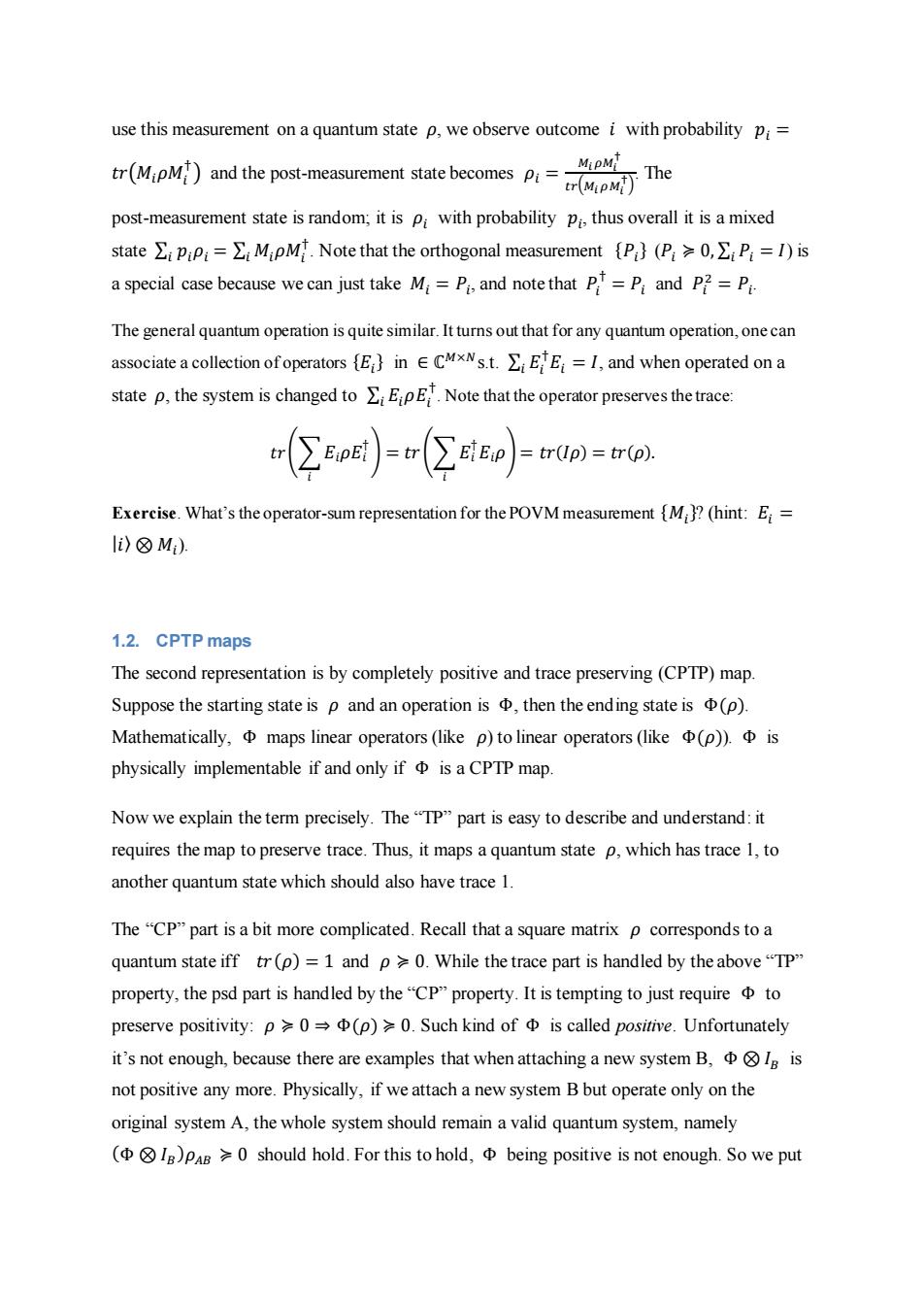
use this measurement on a quantum state p,we observe outcome i with probability pi= tr(MipM)and the post-measurement state becomes pi=- MipM tr(M The post-measurement state is random;it is Pi with probability pi,thus overall it is a mixed state∑iPiPi=∑iM;pM.Note that the orthogonal measurement{P}(P:≥0,∑:P,=I)is a special case because wecan just take M=Pi,and note that P=P and P2=P The general quantum operation is quite similar.It turns out that for any quantum operation,one can associate a collection ofoperators in ECMxNs.t.EE=I,and when operated ona state p,the system is changed to EipE.Note that the operator preserves the trace: (2ep)=r(2iep) =tr(Ip)=tr(p) Exercise.What's the operator-sum representation for the POVM measurement {Mi?(hint:E= li)☒M) 1.2.CPTP maps The second representation is by completely positive and trace preserving (CPTP)map. Suppose the starting state is p and an operation is then the ending state is (p). Mathematically,maps linear operators(like p)to linear operators (like (p)).is physically implementable if and only if is a CPTP map. Now we explain the term precisely.The "TP"part is easy to describe and understand:it requires the map to preserve trace.Thus,it maps a quantum state p,which has trace 1,to another quantum state which should also have trace 1. The "CP"part is a bit more complicated.Recall that a square matrix p corresponds to a quantum state iff tr(p)=1 and p 0.While the trace part is handled by the above"TP" property,the psd part is handled by the"CP"property.It is tempting to just require to preserve positivity:p≥O→Φ(p)≥O.Such kind ofΦis called positive.Unfortunately it's not enough,because there are examples that when attaching a new system B,Ig is not positive any more.Physically,if we attach a new system B but operate only on the original system A,the whole system should remain a valid quantum system,namely (④⑧la)pas>≥0 should hold.For this to hold,Φbeing positive is not enough.So we put
use this measurement on a quantum state 𝜌, we observe outcome 𝑖 with probability 𝑝𝑖 = 𝑡𝑟(𝑀𝑖𝜌𝑀𝑖 † ) and the post-measurement state becomes 𝜌𝑖 = 𝑀𝑖𝜌𝑀𝑖 † 𝑡𝑟(𝑀𝑖𝜌𝑀𝑖 † ) . The post-measurement state is random; it is 𝜌𝑖 with probability 𝑝𝑖 , thus overall it is a mixed state ∑𝑖 𝑝𝑖𝜌𝑖 = ∑ 𝑀𝑖𝜌𝑀𝑖 † 𝑖 . Note that the orthogonal measurement {𝑃𝑖 } (𝑃𝑖 ≽ 0, ∑𝑖 𝑃𝑖 = 𝐼) is a special case because we can just take 𝑀𝑖 = 𝑃𝑖 , and note that 𝑃𝑖 † = 𝑃𝑖 and 𝑃𝑖 2 = 𝑃𝑖 . The general quantum operation is quite similar. It turns out that for any quantum operation, one can associate a collection of operators {𝐸𝑖 } in ∈ ℂ 𝑀×𝑁 s.t. ∑ 𝐸𝑖 † 𝑖 𝐸𝑖 = 𝐼, and when operated on a state 𝜌, the system is changed to ∑ 𝐸𝑖𝜌𝐸𝑖 † 𝑖 . Note that the operator preserves the trace: 𝑡𝑟(∑𝐸𝑖𝜌𝐸𝑖 † 𝑖 ) = 𝑡𝑟 (∑𝐸𝑖 † 𝐸𝑖𝜌 𝑖 ) = 𝑡𝑟(𝐼𝜌) = 𝑡𝑟(𝜌). Exercise. What’s the operator-sum representation for the POVM measurement {𝑀𝑖 }? (hint: 𝐸𝑖 = |𝑖〉 ⊗ 𝑀𝑖 ). 1.2. CPTP maps The second representation is by completely positive and trace preserving (CPTP) map. Suppose the starting state is 𝜌 and an operation is Φ, then the ending state is Φ(𝜌). Mathematically, Φ maps linear operators (like 𝜌) to linear operators (like Φ(𝜌)). Φ is physically implementable if and only if Φ is a CPTP map. Now we explain the term precisely. The “TP” part is easy to describe and understand: it requires the map to preserve trace. Thus, it maps a quantum state 𝜌, which has trace 1, to another quantum state which should also have trace 1. The “CP” part is a bit more complicated. Recall that a square matrix 𝜌 corresponds to a quantum state iff 𝑡𝑟(𝜌) = 1 and 𝜌 ≽ 0. While the trace part is handled by the above “TP” property, the psd part is handled by the “CP” property. It is tempting to just require Φ to preserve positivity: 𝜌 ≽ 0 ⇒ Φ(𝜌) ≽ 0. Such kind of Φ is called positive. Unfortunately it’s not enough, because there are examples that when attaching a new system B, Φ ⊗ 𝐼𝐵 is not positive any more. Physically, if we attach a new system B but operate only on the original system A, the whole system should remain a valid quantum system, namely (Φ ⊗ 𝐼𝐵 )𝜌𝐴𝐵 ≽ 0 should hold. For this to hold, Φ being positive is not enough. So we put
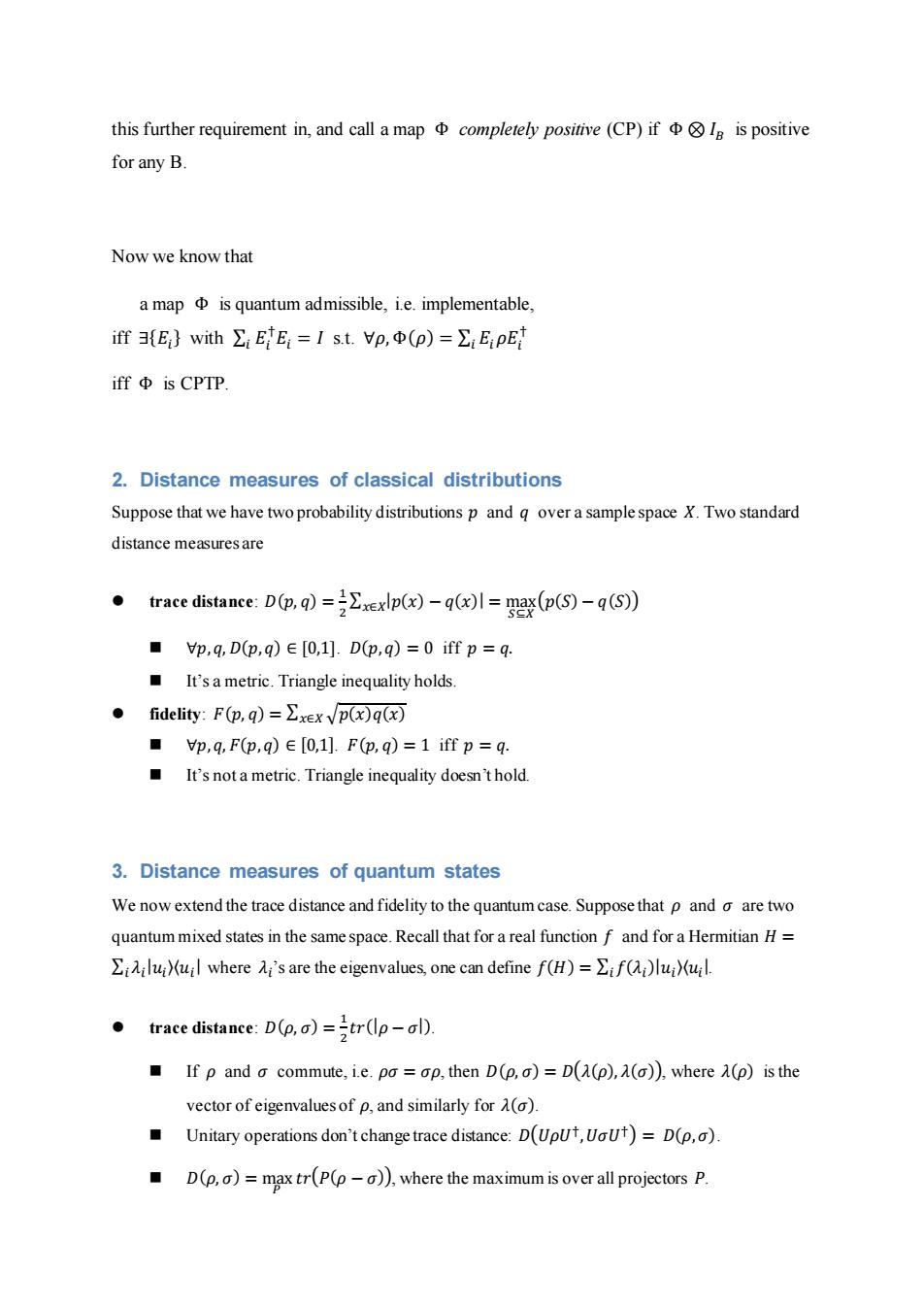
this further requirement in,and call a map completely positive (CP)ifIg is positive for any B. Now we know that a map is quantum admissible,i.e.implementable, if{E}with∑EE:=Ist.Vp,Φ(p)=:EpE iffΦis CPTP. 2.Distance measures of classical distributions Suppose that we have two probability distributions p and q over a sample space X.Two standard distance measures are trace distance:D(p,q)=Exexlp(x)-q(x)I=max(p(S)-q(S)) ■p,q,D(p,q)∈[0,1].D(p,q)=0iffp=q. It's a metric.Triangle inequality holds. ●fidelity:F(p,q)=∑xex /p(x)qa ■p,q,F(p,q)∈[0,1].F(p,q)=1iffp=q. It's not a metric.Triangle inequality doesn't hold. 3.Distance measures of quantum states We now extend the trace distance and fidelity to the quantum case.Suppose that p and o are two quantum mixed states in the same space.Recall that for a real function f and for a Hermitian H= ul where 's are the eigenvalues,one can define f(H)=Eif(lui)uil. trace distance:D(p,a)=tr(lp-al). If p and a commute,i.e.po op,then D(p,)=D((p),())where (p)is the vector of eigenvalues of p,and similarly for A(). Unitary operations don't change trace distance:D(Uput,UoUt)=D(p,o) D(p,a)=max tr(P(p-a)),where the maximum is over all projectors P
this further requirement in, and call a map Φ completely positive (CP) if Φ ⊗ 𝐼𝐵 is positive for any B. Now we know that a map Φ is quantum admissible, i.e. implementable, iff ∃{𝐸𝑖 } with ∑ 𝐸𝑖 † 𝑖 𝐸𝑖 = 𝐼 s.t. ∀𝜌, Φ(𝜌) = ∑ 𝐸𝑖𝜌𝐸𝑖 † 𝑖 iff Φ is CPTP. 2. Distance measures of classical distributions Suppose that we have two probability distributions 𝑝 and 𝑞 over a sample space 𝑋. Two standard distance measures are ⚫ trace distance: 𝐷(𝑝, 𝑞) = 1 2 ∑ |𝑝(𝑥) − 𝑞(𝑥)| 𝑥∈𝑋 = max 𝑆⊆𝑋 (𝑝(𝑆) − 𝑞(𝑆)) ◼ ∀𝑝,𝑞, 𝐷(𝑝,𝑞) ∈ [0,1]. 𝐷(𝑝,𝑞) = 0 iff 𝑝 = 𝑞. ◼ It’s a metric. Triangle inequality holds. ⚫ fidelity: 𝐹(𝑝, 𝑞) = ∑ √𝑝(𝑥)𝑞(𝑥) 𝑥∈𝑋 ◼ ∀𝑝,𝑞, 𝐹(𝑝,𝑞) ∈ [0,1]. 𝐹(𝑝, 𝑞) = 1 iff 𝑝 = 𝑞. ◼ It’s not a metric. Triangle inequality doesn’t hold. 3. Distance measures of quantum states We now extend the trace distance and fidelity to the quantum case. Suppose that 𝜌 and 𝜎 are two quantum mixed states in the same space. Recall that for a real function 𝑓 and for a Hermitian 𝐻 = ∑ 𝜆𝑖 |𝑢𝑖 〉〈𝑢𝑖 | 𝑖 where 𝜆𝑖 ’s are the eigenvalues, one can define 𝑓(𝐻) = ∑ 𝑓(𝜆𝑖 )|𝑢𝑖 〉〈𝑢𝑖 | 𝑖 . ⚫ trace distance: 𝐷(𝜌, 𝜎) = 1 2 𝑡𝑟(|𝜌 − 𝜎|). ◼ If 𝜌 and 𝜎 commute, i.e. 𝜌𝜎 = 𝜎𝜌, then 𝐷(𝜌, 𝜎) = 𝐷(𝜆(𝜌), 𝜆(𝜎)), where 𝜆(𝜌) is the vector of eigenvalues of 𝜌, and similarly for 𝜆(𝜎). ◼ Unitary operations don’t change trace distance: 𝐷(𝑈𝜌𝑈† ,𝑈𝜎𝑈†) = 𝐷(𝜌,𝜎). ◼ 𝐷(𝜌, 𝜎) = max 𝑃 𝑡𝑟(𝑃(𝜌 − 𝜎)), where the maximum is over all projectors 𝑃
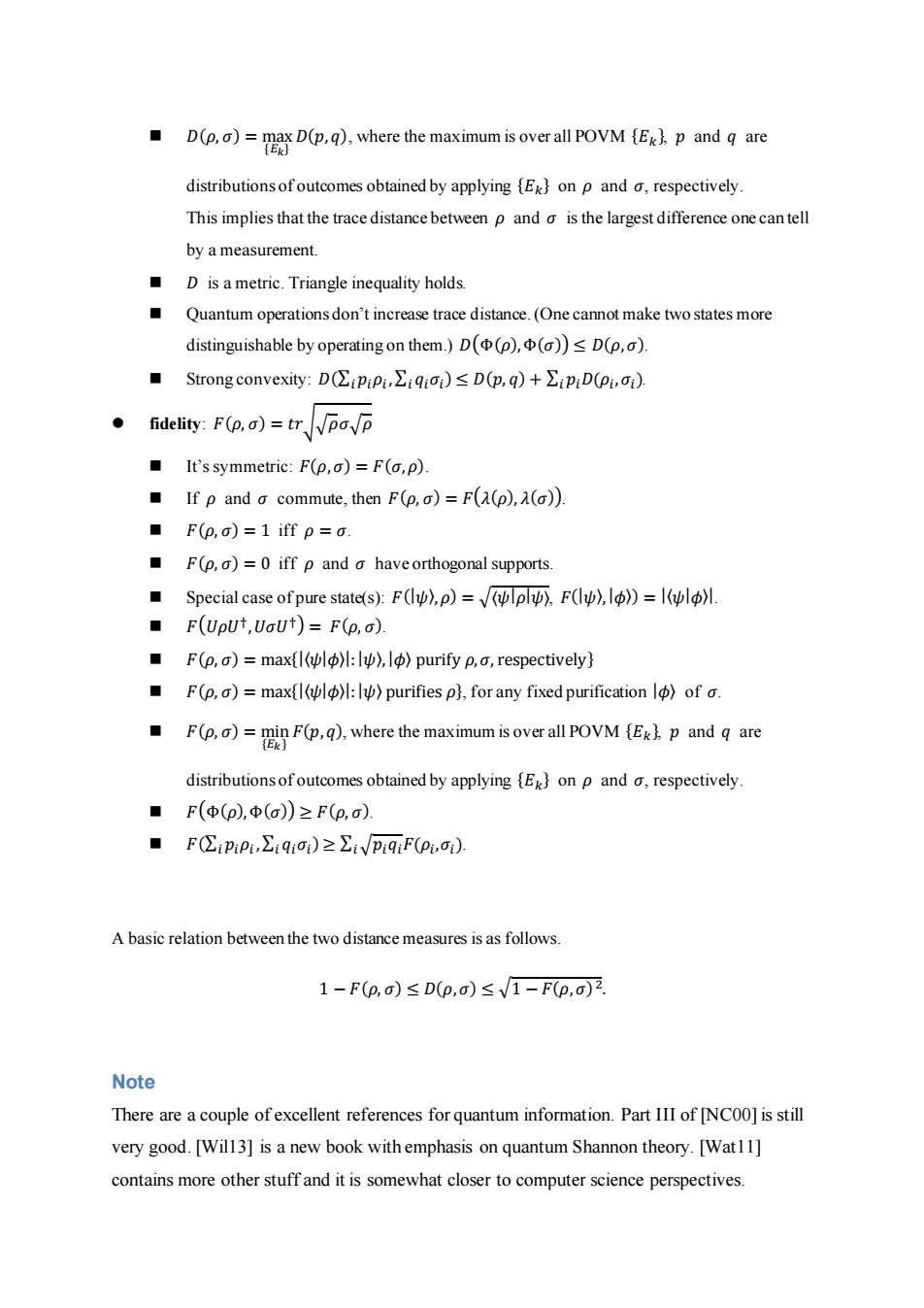
D(p)(p.),where the maximum is over all POVM p and are distributions of outcomes obtained by applying [Ek}on p and o,respectively. This implies that the trace distance between p and o is the largest difference one can tell by a measurement. ■ D is a metric.Triangle inequality holds. Quantum operations don't increase trace distance.(One cannot make two states more distinguishable by operating on them.)D((p),())D(p,) ■Strong convexity:D(iPiPi,∑iqioi)≤D(p,q)+∑ipiD(pi,oi) 。fidelity:Fo,o)=trpa万 It's symmetric:F(p,o)=F(a,p). If p and o commute,then F(p,a)=F((p),()) ■F(p,o)=1iffp=0. F(p,o)=0 iff p and o haveorthogonal supports Special case of pure state(s):F(),p)=)F())=) F(UpUt,UoUt)=F(p,a). F(p,a)=max{):),lo)purify p,o,respectively} F(p,o)=max{l):l)purifies p},for any fixed purification lo)of a. F(p)(.).where the maximum is over all POVM Ex p and q are distributions ofoutcomes obtained by applying [Ek}on p and o,respectively ■F((p),Φ(a)≥F(p,o). ■ FCiPiP1,∑iqio)≥∑iPiqiF(P,o) A basic relation between the two distance measures is as follows. 1-F(p,o)≤D(p,o)≤V1-F(0,G)2 Note There are a couple of excellent references for quantum information.Part III of [NC0O]is still very good.[Will3]is a new book with emphasis on quantum Shannon theory.[Wat11] contains more other stuff and it is somewhat closer to computer science perspectives
◼ 𝐷(𝜌, 𝜎) = max {𝐸𝑘} 𝐷(𝑝,𝑞), where the maximum is over all POVM {𝐸𝑘 }, 𝑝 and 𝑞 are distributions of outcomes obtained by applying {𝐸𝑘 } on 𝜌 and 𝜎, respectively. This implies that the trace distance between 𝜌 and 𝜎 is the largest difference one can tell by a measurement. ◼ 𝐷 is a metric. Triangle inequality holds. ◼ Quantum operations don’t increase trace distance. (One cannot make two states more distinguishable by operating on them.) 𝐷(Φ(𝜌),Φ(𝜎)) ≤ 𝐷(𝜌,𝜎). ◼ Strong convexity: 𝐷(∑𝑖 𝑝𝑖𝜌𝑖 ,∑𝑖 𝑞𝑖𝜎𝑖 ) ≤ 𝐷(𝑝, 𝑞) + ∑ 𝑝𝑖𝐷(𝜌𝑖 𝑖 ,𝜎𝑖). ⚫ fidelity: 𝐹(𝜌, 𝜎) = 𝑡𝑟√√𝜌𝜎√𝜌 ◼ It’s symmetric: 𝐹(𝜌,𝜎) = 𝐹(𝜎,𝜌). ◼ If 𝜌 and 𝜎 commute, then 𝐹(𝜌, 𝜎) = 𝐹(𝜆(𝜌), 𝜆(𝜎)). ◼ 𝐹(𝜌, 𝜎) = 1 iff 𝜌 = 𝜎. ◼ 𝐹(𝜌, 𝜎) = 0 iff 𝜌 and 𝜎 have orthogonal supports. ◼ Special case of pure state(s): 𝐹(|𝜓〉,𝜌) = √〈𝜓|𝜌|𝜓〉, 𝐹(|𝜓〉,|𝜙〉) = |〈𝜓|𝜙〉|. ◼ 𝐹(𝑈𝜌𝑈† ,𝑈𝜎𝑈†) = 𝐹(𝜌, 𝜎). ◼ 𝐹(𝜌, 𝜎) = max{|〈𝜓|𝜙〉|:|𝜓〉,|𝜙〉 purify 𝜌,𝜎, respectively} ◼ 𝐹(𝜌, 𝜎) = max{|〈𝜓|𝜙〉|:|𝜓〉 purifies 𝜌}, for any fixed purification |𝜙〉 of 𝜎. ◼ 𝐹(𝜌, 𝜎) = min {𝐸𝑘} 𝐹(𝑝,𝑞), where the maximum is over all POVM {𝐸𝑘 }, 𝑝 and 𝑞 are distributions of outcomes obtained by applying {𝐸𝑘 } on 𝜌 and 𝜎, respectively. ◼ 𝐹(Φ(𝜌),Φ(𝜎)) ≥ 𝐹(𝜌, 𝜎). ◼ 𝐹(∑𝑖 𝑝𝑖𝜌𝑖 ,∑𝑖 𝑞𝑖𝜎𝑖 ) ≥ ∑ √𝑝𝑖𝑞𝑖𝐹(𝜌𝑖 𝑖 ,𝜎𝑖). A basic relation between the two distance measures is as follows. 1 − 𝐹(𝜌, 𝜎) ≤ 𝐷(𝜌,𝜎) ≤ √1 − 𝐹(𝜌,𝜎) 2 . Note There are a couple of excellent references for quantum information. Part III of [NC00] is still very good. [Wil13] is a new book with emphasis on quantum Shannon theory. [Wat11] contains more other stuff and it is somewhat closer to computer science perspectives
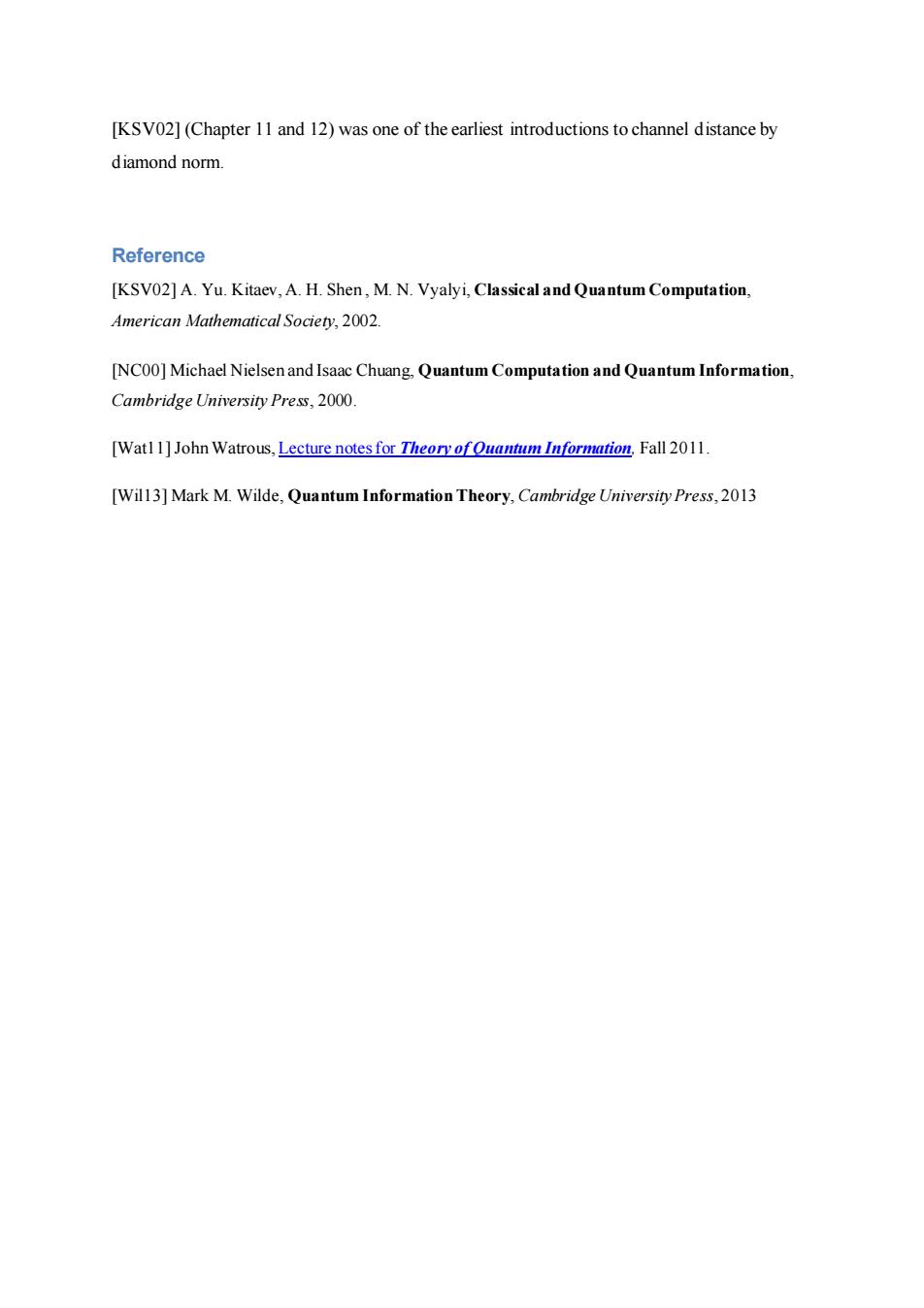
[KSV02](Chapter 11 and 12)was one of the earliest introductions to channel distance by diamond norm. Reference [KSV02]A.Yu.Kitaev,A.H.Shen,M.N.Vyalyi,Classical and Quantum Computation, American Mathematical Society,2002. [NC0O]Michael Nielsen and Isaac Chuang,Quantum Computation and Quantum Information, Cambridge University Press,2000 [Wat1 1]John Watrous,Lecture notes for Theory of Ouantum Information,Fall 2011. [Will3]Mark M.Wilde,Quantum Information Theory,Cambridge University Press,2013
[KSV02] (Chapter 11 and 12) was one of the earliest introductions to channel distance by diamond norm. Reference [KSV02] A. Yu. Kitaev, A. H. Shen , M. N. Vyalyi, Classical and Quantum Computation, American Mathematical Society, 2002. [NC00] Michael Nielsen and Isaac Chuang, Quantum Computation and Quantum Information, Cambridge University Press, 2000. [Wat11] John Watrous, Lecture notes for Theory of Quantum Information, Fall 2011. [Wil13] Mark M. Wilde, Quantum Information Theory, Cambridge University Press, 2013